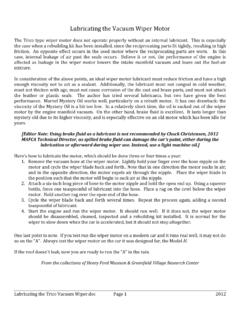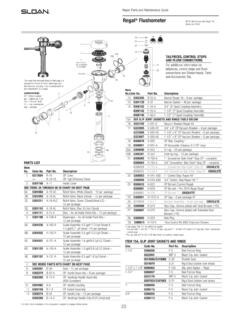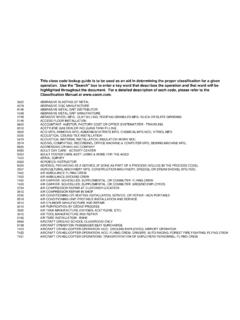Transcription of The Zenith Carburetor
1 Page 1 The Zenith Carburetor (revised 2010) by Tom Endy Zenith Carburetor documentation: Good grief! Another article on the Model A Ford Zenith Carburetor . Enough already! There must be a whole floor in the library of congress devoted to articles written about this Carburetor . But wait! If you are into rebuilding Zenith carburetors you might want to read this. This article is about an easy way to check if the internal passageways in the Carburetor are open or plugged. The Secret Passageways: Most of the articles written about the Zenith Carburetor speak of these mystic passageways and the importance of them not being plugged up with dirt and debris. Several describe various confusing ways to check if they are clear by using specially made tools and employing exotic methods.
2 Some also describe how you can drill out the brass plugs installed by the manufacturer to allow access for cleaning out the various passageways. Replacement plugs are readily available from your favorite Model A Ford parts store under part number A-9593. My own experience has been that the plugs should not be drilled out unless it is certain a passageway is plugged and can't be cleared, then only drill out the plug that provides the access to that passageway. Drilling the plugs out on every Carburetor being rebuilt is not a good idea, since it is easy to inflict damage to the Carburetor . Lessons Learned: It is easy to break a drill bit off halfway through the brass plug. It is also easy to drill the hole off center, ending up with an oversize hole. It is possible to wedge a piece of the drilled out plug material deep inside the passageway.
3 The new repo plugs may not seal off the hole when they are installed causing the Carburetor to leak either air or gas. I also managed to crack an upper housing once when I was in the process of tapping a new plug into the large hole in the throat. The new repo plug was larger than it needed to be, and as I made the last tap, the cast iron cracked top and bottom of the hole. The Proper Tools: The only tools you need to check the passageways in both the upper and lower castings is an ordinary garden variety paper clip and a penlight. How To Check The Lower Casting! Remove all the hardware from the lower casting including the jets, the secondary well, and the gas adjust needle housing. Straighten the paper clip so it is a straight piece of wire and bend a slight curve at one end.
4 Refer to figure one and follow the four steps below. Step one: Insert the curved end of the paper clip in the main jet feed hole labeled hole "A" at item #1. The passageway curves inward toward the center of the casting. Wiggle and push the wire and the end should emerge and be visible at the hole for the main jet at Item #2. These are the only two openings to this passageway. Page 2 Step two: Insert the curved end of the paper clip into the hole for the compensator jet at item #3. The wire should enter a hole at the bottom of one side of the secondary well at item #4, pass through the well to a hole on the opposite side, and the end of the wire should emerge at the hole for the cap jet at item #5. Shine the penlight down into the secondary well and you should see the wire passing through at the bottom of the well.
5 Shine the penlight down into the hole for the cap jet and you should see the end of the wire at the bottom of the hole. Step three: Insert the curved end of the wire into the gas adjust needle feed hole labeled hole "B" at item #6. The other end should emerge at the bottom of the hole for the gas adjust needle valve at item #7. Shine the penlight down into the gas adjust hole and you should be able to see the end of the wire below the valve seat. Step four: The last passageway to check is a little more difficult, but it can be done. Shine the penlight down into the gas adjust needle hole at item #7 and locate a small hole just above the valve seat at either the 10 O'clock position or the 5 O'clock position. There is a variation in castings. Insert the curved end of the paper clip into this hole. You may have to curve the end of the wire slightly more.
6 Wiggle and push the wire and if the hole is at the 10 O'clock position it should emerge into the secondary well at item #4. Shine the penlight down into the secondary well and you should be able to see the end of wire at the bottom of the well. If the hole is at the 5 O'clock position the wire will emerge in the hole for the cap jet at item #5. Shine the penlight down into the hole for the cap jet and you should be able to see the end of the wire at the bottom of the hole. If you were successful in passing the paper clip wire though the passageways in all of the steps above, you can be confident all the passageways in the bottom casting are clear. How To Check The Upper Casting: Remove all the hardware from the upper casting, including the idle jet and the air idle adjust valve screw. Refer to figure two and follow the three steps below.
7 Step one: Insert the paper clip wire into the air idle adjust valve screw hole at item #1. The end of the wire should be visible passing through the hole for the idle jet at item #2 and emerging at the air vent hole labeled hole "C" at item #3. Step two: It may be possible to insert the paper clip wire into the idle jet hole at item #2, and push and wiggle it until it reaches the small hole in the throat of the Carburetor next to the throttle plate edge at item #4. This hole is labeled hole "D". This is very difficult to do since you have to get the wire around two bends in the passage way. An easier method is to get a can of WD40 with the little red straw that normally comes with it and insert the end of the straw into the throat hole labeled hole "D", at item #4, and give it a shot of WD40. The WD40 should come shooting out of the idle jet hole at item #2.
8 Page 3 Step three: There is a " long passageway drilled underneath the gasket surface between the recessed area for the idle jet and the recessed area for the gas bowl. The two holes are indicated at item #5 and item #6 and are labeled holes "E" and "F". Pass the paper clip wire through the passageway to make certain that it is open. If you were successful in passing the paper clip wire or WD40 through the passageways indicated in the steps above you can be confident all the passageways in the upper casting are open. Checking Valve Functions: Now that you are certain that all the passageways are open, it is a good idea to check how well the air idle adjust valve and gas adjust valve work. There is an easy way to test each. The Air Idle Adjust Check: The check is done with the upper casting completely assembled except for the float.
9 The float can be left off for convenience. Refer to figure two. Close the air idle valve by screwing down the air idle adjust screw until it hits the valve seat. Hold your finger over the small hole in the throat labeled hole "D" at item #4. Suck on the end of the idle jet (probably taste like WD40). No air should pass, if it does it means that the valve does not seat and it is allowing air to get past it. Continue sucking on the end of the idle jet, and at the same time back off on the air idle adjust screw. Air should begin to pass. This is a test you should always do because there are a lot of repo adjusting screws around that are not long enough to close the valve. Check the length of the screw to make certain it hits the valve seat. The Gas Adjust Needle Valve: To check the gas adjust valve, the lower casting must be completely assembled.
10 Refer to figure one. Remove the compensator jet. The compensator jet is the stubby little fellow in the gas bowl at item #3. Replace the jet with a 10-32 screw. The threads are actually a 10-34, but they will accept the 10-32 screw without inflicting damage to the threads. Open the gas adjust needle valve at Item #7 by backing the needle out two full turns. Place the lower casting on a flat surface and prop it up so that it is also level. Fill the gas bowl with gasoline up to about " from the top. If you are squeamish about using gasoline, you can use water. Place your finger over the secondary well at item #4 and press firmly. Again using the WD40 with the little red straw, put the end of the straw over the end of the cap jet at item #5 and give it a shot of WD40.


